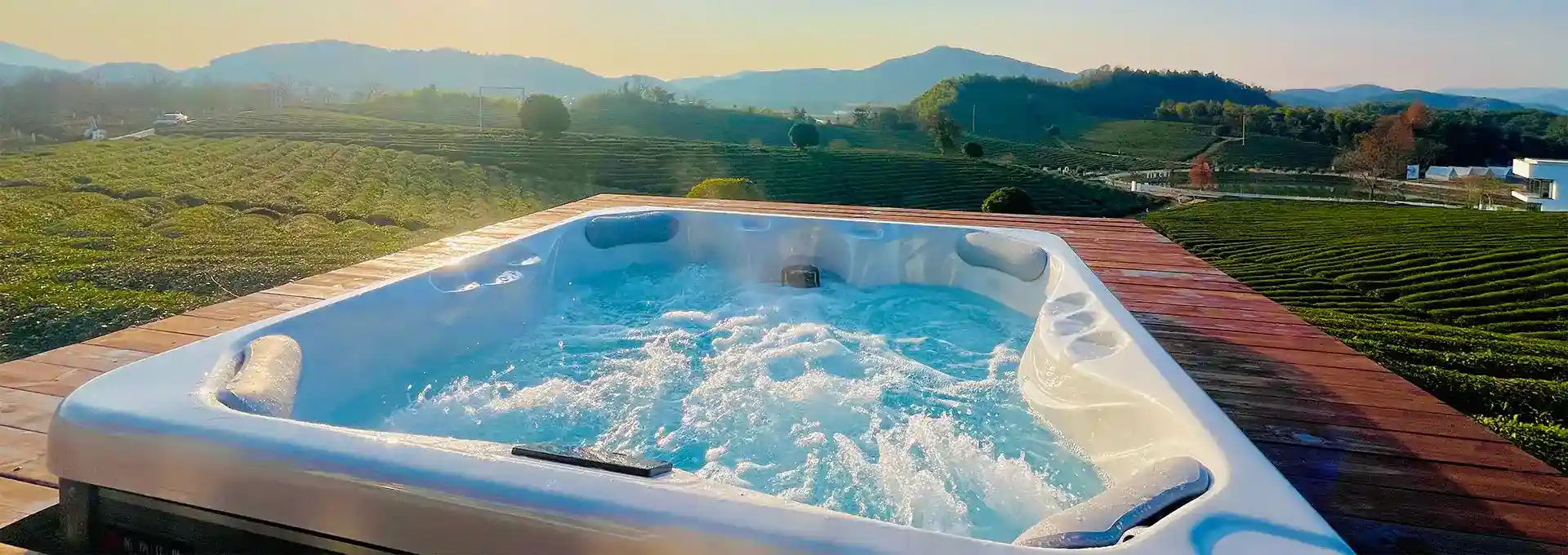How Warm Does a Swim Spa Get?
2024-09-29 09:55:22
Swim spas have become increasingly popular for those seeking a versatile aquatic experience at home. One of the most common questions potential buyers ask is about the temperature range of these innovative pools. So, how warm does a luxury 7 seater swim spa get? Typically, swim spas can reach temperatures between 80°F and 104°F (26.7°C to 40°C), allowing users to enjoy comfortable swimming and relaxation in various seasons. This wide temperature range makes swim spas suitable for different activities, from invigorating exercise to soothing hydrotherapy.
What are the benefits of a luxury 7 seater swim spa?
A luxury 7 seater swim spa offers a myriad of benefits that cater to both fitness enthusiasts and those seeking relaxation. These high-end units combine the best features of a swimming pool and a hot tub, providing a versatile aquatic experience in a compact space. Here are some of the key advantages:
1. Year-round use: Unlike traditional pools, swim spas can be used throughout the year, regardless of the weather. Their adjustable temperature settings allow for comfortable swimming and soaking in any season.
2. Versatile exercise options: The swim current in these spas provides an excellent opportunity for low-impact aquatic exercises. Users can swim, jog, or perform water aerobics without the need for a full-sized pool.
3. Hydrotherapy and relaxation: The 7 seating positions typically feature various jet configurations, offering targeted massage and hydrotherapy benefits. This can help alleviate muscle tension, reduce stress, and promote overall well-being.
4. Space-efficient design: Luxury swim spas offer the benefits of both a pool and a hot tub in a fraction of the space required for separate installations. This makes them ideal for smaller backyards or properties with limited outdoor areas.
5. Energy efficiency: Modern swim spas are designed with energy-efficient features, such as superior insulation and smart heating systems. This helps minimize operating costs while maintaining optimal water temperature.
6. Social gathering spot: With seating for seven people, these swim spas provide an excellent venue for social gatherings, family time, or entertaining guests.
7. Customizable features: Many luxury swim spas come with adjustable current speeds, programmable workout routines, and even built-in audio systems for an enhanced user experience.
8. Low maintenance: Compared to traditional pools, swim spas require less maintenance and fewer chemicals, making them a more convenient option for homeowners.
9. Potential health benefits: Regular use of a swim spa can contribute to improved cardiovascular health, muscle strength, and flexibility. The warm water and massage jets can also help with pain relief and better sleep quality.
10. Increased property value: Installing a luxury swim spa can potentially increase the value of your property, making it an attractive feature for future buyers if you decide to sell your home.
How does water temperature affect swim spa performance?
Water temperature plays a crucial role in the performance and enjoyment of a swim spa. The ideal temperature can vary depending on the intended use, whether it's for exercise, relaxation, or therapy. Understanding how water temperature affects swim spa performance can help users optimize their experience:
1. Exercise and fitness: For swimming and aquatic exercises, cooler temperatures between 78°F and 84°F (25.5°C to 28.9°C) are generally preferred. This range helps maintain a comfortable body temperature during physical activity, preventing overheating and allowing for longer workout sessions.
2. Muscle recovery: After intense exercise, slightly warmer temperatures around 90°F to 95°F (32.2°C to 35°C) can be beneficial. This warmth helps relax muscles, reduce lactic acid buildup, and promote faster recovery.
3. Relaxation and stress relief: For pure relaxation, many users prefer temperatures between 96°F and 102°F (35.6°C to 38.9°C). This warmth promotes muscle relaxation, improves circulation, and induces a sense of calm.
4. Hydrotherapy: For therapeutic purposes, temperatures between 98°F and 104°F (36.7°C to 40°C) are often recommended. This range can help alleviate chronic pain, reduce inflammation, and improve joint mobility.
5. Energy consumption: Higher water temperatures require more energy to maintain, which can impact operating costs. Finding a balance between comfort and energy efficiency is important for long-term use.
6. Water resistance: As water temperature increases, its viscosity decreases slightly. This can affect the feel of the water during swimming, potentially requiring adjustments to the swim current for optimal performance.
7. Chemical balance: Water temperature affects the rate at which chemicals work and dissipate in the swim spa. Higher temperatures may necessitate more frequent chemical testing and adjustments to maintain proper water quality.
8. Seasonal considerations: The ambient temperature can influence the swim spa's performance. In colder months, maintaining higher water temperatures may require more energy, while in warmer seasons, lower temperatures might be more comfortable and energy-efficient.
9. User comfort: Personal preference plays a significant role in determining the ideal water temperature. Some users may prefer cooler temperatures for invigorating swims, while others might enjoy warmer water for relaxation.
10. Duration of use: The length of time spent in the swim spa can also influence the ideal temperature. For extended use, slightly lower temperatures may be more comfortable and reduce the risk of dehydration or overheating.
By understanding these factors, swim spa owners can adjust the water temperature to suit their specific needs and maximize the benefits of their luxury 7 seater swim spa. It's important to note that most high-end swim spas come with precise temperature controls, allowing users to fine-tune the water temperature for optimal performance and enjoyment.
What safety precautions should be taken when using a heated swim spa?
While luxury 7 seater swim spas offer numerous benefits, it's essential to prioritize safety when using these heated aquatic environments. By following proper safety precautions, users can ensure a safe and enjoyable experience for themselves and their guests. Here are some key safety measures to consider:
1. Temperature control: Always check the water temperature before entering the swim spa. The Consumer Product Safety Commission recommends that water temperature should not exceed 104°F (40°C) for adults and 98°F (36.7°C) for children. Prolonged exposure to high temperatures can lead to hyperthermia, dehydration, or other health risks.
2. Time limits: Limit your time in the heated swim spa, especially when the water is at higher temperatures. It's generally recommended to stay in for no more than 15-20 minutes at a time when the water is above 98°F (36.7°C). Take breaks to cool down and rehydrate.
3. Hydration: Drink plenty of water before, during, and after using the swim spa. The warm water can cause sweating and fluid loss, even if you don't notice it, increasing the risk of dehydration.
4. Medical considerations: Individuals with certain medical conditions, such as heart disease, diabetes, or high blood pressure, should consult their healthcare provider before using a heated swim spa. Pregnant women should also seek medical advice, as prolonged exposure to high temperatures may pose risks to fetal development.
5. Alcohol and drug use: Avoid consuming alcohol or drugs before or during swim spa use. These substances can impair judgment, increase the risk of accidents, and exacerbate the effects of heat exposure.
6. Supervision: Never leave children unattended in or around the swim spa. Designate a responsible adult to supervise at all times, and consider installing a locked safety cover when the spa is not in use.
7. Non-slip surfaces: Ensure that the area around the swim spa has non-slip surfaces to prevent accidents. Many luxury swim spas come with textured steps and surrounds, but additional mats may be necessary for added safety.
8. Proper lighting: If the swim spa is used during evening hours, ensure adequate lighting in and around the spa area to prevent trips and falls.
9. Emergency shut-off: Familiarize yourself and other users with the location of the emergency shut-off switch. This can be crucial in case of an emergency or if someone becomes trapped by the suction of the spa jets.
10. Water quality maintenance: Regularly test and maintain proper water chemistry to prevent the growth of harmful bacteria and ensure a safe swimming environment. Follow the manufacturer's guidelines for chemical use and filtration.
11. Electrical safety: Ensure that all electrical components of the swim spa are properly installed and maintained by a qualified professional. Never use electrical devices near or in the swim spa.
12. Weather awareness: Be cautious when using the swim spa in extreme weather conditions. During thunderstorms, exit the spa immediately to avoid the risk of lightning strikes.
13. Entry and exit safety: Use the designated entry and exit points of the swim spa, typically equipped with handrails or steps. Avoid climbing over the sides, which can be slippery and increase the risk of falls.
14. Proper attire: Wear appropriate swimwear that won't get caught in the spa's jets or filtration system. Avoid loose clothing that could become waterlogged and heavy.
15. Emergency preparedness: Keep a phone nearby in case of emergencies, and consider having basic first aid supplies on hand. Knowing CPR can also be invaluable in aquatic environments.
By adhering to these safety precautions, users can maximize the enjoyment and benefits of their luxury 7 seater swim spa while minimizing potential risks. It's important to educate all users about these safety measures and to create a culture of responsible use. Many swim spa manufacturers provide comprehensive safety guidelines specific to their models, which should be thoroughly reviewed and followed.
Remember that while swim spas offer a controlled environment compared to open water, they still require respect and caution. By prioritizing safety, users can fully embrace the therapeutic, fitness, and social benefits that these versatile aquatic systems provide, ensuring countless hours of safe, healthy, and enjoyable experiences for years to come.
For more information on hot tub installations and to find out more about our products, please feel free to contact us at info@iparnassus.com.
References
1. Swim University. (2023). "The Ultimate Guide to Swim Spa Temperature."
2. Hydropool Swim Spas. (2024). "Benefits of Swim Spas."
3. Aqua Magazine. (2022). "The Pros and Cons of Swim Spas."
4. Master Spas. (2024). "Swim Spa Temperature Guide."
5. SwimEx. (2023). "The Importance of Water Temperature in Aquatic Therapy."
6. Pool and Spa News. (2022). "Safety First: Best Practices for Swim Spa Use."
7. American Red Cross. (2024). "Swimming and Water Safety."
8. Centers for Disease Control and Prevention. (2023). "Healthy Swimming."
9. Energy.gov. (2023). "Energy-Efficient Home Swimming Pools and Spas."
10. Association of Pool & Spa Professionals. (2024). "Spa & Hot Tub Safety."



